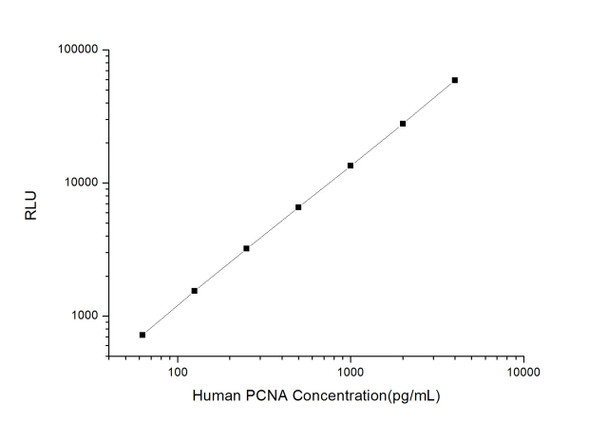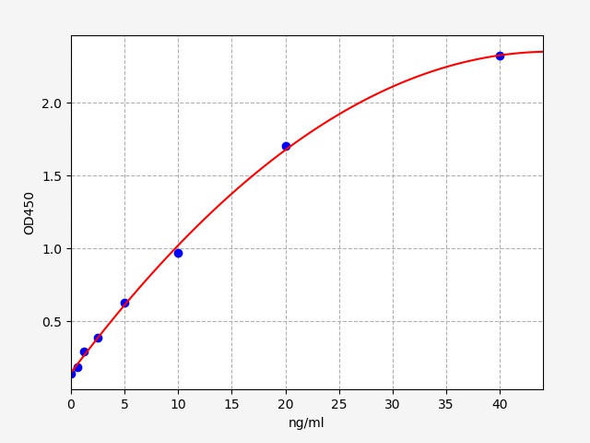Human Epigenetics and Nuclear Signaling ELISA Kits
Human PCNA (Proliferating Cell Nuclear Antigen) CLIA Kit (HUES01246)
- SKU:
- HUES01246
- Product Type:
- ELISA Kit
- ELISA Type:
- CLIA Kit
- Size:
- 96 Assays
- Sensitivity:
- 37.5pg/mL
- Range:
- 62.5-4000pg/mL
- ELISA Type:
- Sandwich
- Reactivity:
- Human
- Sample Type:
- Serum, plasma and other biological fluids
- Research Area:
- Epigenetics and Nuclear Signaling
Description
| Assay type: | Sandwich |
| Format: | 96T |
| Assay time: | 4.5h |
| Reactivity: | Human |
| Detection method: | Chemiluminescence |
| Detection range: | 62.50-4000 pg/mL |
| Sensitivity: | 37.50 pg/mL |
| Sample volume: | 100µL |
| Sample type: | Serum, plasma and other biological fluids |
| Repeatability: | CV < 15% |
| Specificity: | This kit recognizes Human PCNA in samples. No significant cross-reactivity or interference between Human PCNA and analogues was observed. |
This kit uses Sandwich-CLIA as the method. The micro CLIA plate provided in this kit has been pre-coated with an antibody specific to Human PCNA. Standards or samples are added to the appropriate micro CLIA plate wells and combined with the specific antibody. Then a biotinylated detection antibody specific for Human PCNA and Avidin-Horseradish Peroxidase (HRP) conjugate are added to each micro plate well successively and incubated. Free components are washed away. The substrate solution is added to each well. Only those wells that contain Human PCNA, biotinylated detection antibody and Avidin-HRP conjugate will appear fluorescence. The Relative light unit (RLU) value is measured spectrophotometrically by the Chemiluminescence immunoassay analyzer. The RLU value is positively associated with the concentration of Human PCNA. The concentration of Human PCNA in the samples can be calculated by comparing the RLU of the samples to the standard curve.
| UniProt Protein Function: | PCNA: This protein is an auxiliary protein of DNA polymerase delta and is involved in the control of eukaryotic DNA replication by increasing the polymerase's processibility during elongation of the leading strand. Induces a robust stimulatory effect on the 3'- 5' exonuclease and 3'-phosphodiesterase, but not apurinic- apyrimidinic (AP) endonuclease, APEX2 activities. Has to be loaded onto DNA in order to be able to stimulate APEX2. Homotrimer. Forms a complex with activator 1 heteropentamer in the presence of ATP. Interacts with EXO1, POLH, POLK, DNMT1, ERCC5, FEN1, CDC6 and POLDIP2. Interacts with APEX2; this interaction is triggered by reactive oxygen species and increased by misincorporation of uracil in nuclear DNA. Forms a ternary complex with DNTTIP2 and core histone. Interacts with KCTD10 and PPP1R15A. Interacts with POLD1, POLD3 and POLD4. Interacts with BAZ1B; the interaction is direct. Interacts with HLTF and SHPRH. Interacts with NUDT15. Interaction is disrupted in response to UV irradiation and acetylation. Interacts with p21Cip1/p21(CIP1) and CDT1; interacts via their PIP-box which also recruits the DCX(DTL) complex. Interacts with DDX11. Interacts with EGFR; positively regulates PCNA. Interacts with C12orf48/PARI. Interacts with SMARCAD1. Belongs to the PCNA family. |
| UniProt Protein Details: | Protein type:DNA replication; Cell cycle regulation Chromosomal Location of Human Ortholog: 20pter-p12 Cellular Component: nucleoplasm; centrosome; PCNA complex; nuclear replication fork; cytoplasm; DNA replication factor C complex; nucleus Molecular Function:identical protein binding; protein binding; DNA polymerase processivity factor activity; MutLalpha complex binding; purine-specific mismatch base pair DNA N-glycosylase activity; receptor tyrosine kinase binding; dinucleotide insertion or deletion binding Biological Process: mismatch repair; heart development; positive regulation of deoxyribonuclease activity; DNA strand elongation during DNA replication; response to lipid; DNA repair; leading strand elongation; G1/S-specific transcription in mitotic cell cycle; telomere maintenance via semi-conservative replication; cell proliferation; bypass DNA synthesis; response to cadmium ion; epithelial cell differentiation; base-excision repair; nucleotide-excision repair; transcription-coupled nucleotide-excision repair; telomere maintenance via recombination; nucleotide-excision repair, DNA gap filling; mitotic cell cycle; telomere maintenance; regulation of DNA replication; G1/S transition of mitotic cell cycle Disease: Ataxia-telangiectasia-like Disorder 2 |
| NCBI Summary: | The protein encoded by this gene is found in the nucleus and is a cofactor of DNA polymerase delta. The encoded protein acts as a homotrimer and helps increase the processivity of leading strand synthesis during DNA replication. In response to DNA damage, this protein is ubiquitinated and is involved in the RAD6-dependent DNA repair pathway. Two transcript variants encoding the same protein have been found for this gene. Pseudogenes of this gene have been described on chromosome 4 and on the X chromosome. [provided by RefSeq, Jul 2008] |
| UniProt Code: | P12004 |
| NCBI GenInfo Identifier: | 129694 |
| NCBI Gene ID: | 5111 |
| NCBI Accession: | P12004. 1 |
| UniProt Secondary Accession: | P12004,B2R897, D3DW02, |
| UniProt Related Accession: | P12004 |
| Molecular Weight: | 261 |
| NCBI Full Name: | Proliferating cell nuclear antigen |
| NCBI Synonym Full Names: | proliferating cell nuclear antigen |
| NCBI Official Symbol: | PCNA |
| NCBI Official Synonym Symbols: | ATLD2 |
| NCBI Protein Information: | proliferating cell nuclear antigen; cyclin; DNA polymerase delta auxiliary protein |
| UniProt Protein Name: | Proliferating cell nuclear antigen |
| UniProt Synonym Protein Names: | Cyclin |
| Protein Family: | PCNA-associated factor |
| UniProt Gene Name: | PCNA |
| UniProt Entry Name: | PCNA_HUMAN |
As the RLU values of the standard curve may vary according to the conditions of the actual assay performance (e. g. operator, pipetting technique, washing technique or temperature effects), the operator should establish a standard curve for each test. Typical standard curve and data is provided below for reference only.
| Concentration (pg/mL) | RLU | Average | Corrected |
| 4000 | 57388 60774 | 59081 | 59046 |
| 2000 | 26114 29604 | 27859 | 27824 |
| 1000 | 14103 12865 | 13484 | 13449 |
| 500 | 6221 6989 | 6605 | 6570 |
| 250 | 3421 3065 | 3243 | 3208 |
| 125 | 1612 1550 | 1581 | 1546 |
| 62.50 | 708 802 | 755 | 720 |
| 0 | 35 35 | 35 | -- |
Precision
Intra-assay Precision (Precision within an assay): 3 samples with low, mid range and high level Human PCNA were tested 20 times on one plate, respectively.
Inter-assay Precision (Precision between assays): 3 samples with low, mid range and high level Human PCNA were tested on 3 different plates, 20 replicates in each plate.
| Intra-assay Precision | Inter-assay Precision | |||||
| Sample | 1 | 2 | 3 | 1 | 2 | 3 |
| n | 20 | 20 | 20 | 20 | 20 | 20 |
| Mean (pg/mL) | 216.97 | 430.99 | 1672.32 | 207.91 | 412.45 | 1759.76 |
| Standard deviation | 25.99 | 47.67 | 105.02 | 25.37 | 45.78 | 113.86 |
| C V (%) | 11.98 | 11.06 | 6.28 | 12.20 | 11.10 | 6.47 |
Recovery
The recovery of Human PCNA spiked at three different levels in samples throughout the range of the assay was evaluated in various matrices.
| Sample Type | Range (%) | Average Recovery (%) |
| Serum (n=5) | 97-109 | 103 |
| EDTA plasma (n=5) | 90-108 | 98 |
| Cell culture media (n=5) | 84-97 | 91 |
Linearity
Samples were spiked with high concentrations of Human PCNA and diluted with Reference Standard & Sample Diluent to produce samples with values within the range of the assay.
| Serum (n=5) | EDTA plasma (n=5) | Cell culture media (n=5) | ||
| 1:2 | Range (%) | 95-108 | 90-104 | 88-100 |
| Average (%) | 102 | 96 | 95 | |
| 1:4 | Range (%) | 96-111 | 85-100 | 95-109 |
| Average (%) | 104 | 91 | 102 | |
| 1:8 | Range (%) | 91-106 | 89-101 | 93-108 |
| Average (%) | 97 | 94 | 100 | |
| 1:16 | Range (%) | 96-108 | 93-107 | 102-116 |
| Average (%) | 102 | 99 | 107 |
An unopened kit can be stored at 4°C for 1 month. If the kit is not used within 1 month, store the items separately according to the following conditions once the kit is received.
| Item | Specifications | Storage |
| Micro CLIA Plate(Dismountable) | 8 wells ×12 strips | -20°C, 6 months |
| Reference Standard | 2 vials | |
| Concentrated Biotinylated Detection Ab (100×) | 1 vial, 120 µL | |
| Concentrated HRP Conjugate (100×) | 1 vial, 120 µL | -20°C(shading light), 6 months |
| Reference Standard & Sample Diluent | 1 vial, 20 mL | 4°C, 6 months |
| Biotinylated Detection Ab Diluent | 1 vial, 14 mL | |
| HRP Conjugate Diluent | 1 vial, 14 mL | |
| Concentrated Wash Buffer (25×) | 1 vial, 30 mL | |
| Substrate Reagent A | 1 vial, 5 mL | 4°C (shading light) |
| Substrate Reagent B | 1 vial, 5 mL | 4°C (shading light) |
| Plate Sealer | 5 pieces | |
| Product Description | 1 copy | |
| Certificate of Analysis | 1 copy |
- Set standard, test sample and control (zero) wells on the pre-coated plate and record theirpositions. It is recommended to measure each standard and sample in duplicate. Note: addall solutions to the bottom of the plate wells while avoiding contact with the well walls. Ensuresolutions do not foam when adding to the wells.
- Aliquot 100 µL of standard solutions into the standard wells.
- Add 100 µL of Sample / Standard dilution buffer into the control (zero) well.
- Add 100 µL of properly diluted sample (serum, plasma, tissue homogenates and otherbiological fluids. ) into test sample wells.
- Cover the plate with the sealer provided in the kit and incubate for 90 min at 37 °C.
- Aspirate the liquid from each well, do not wash. Immediately add 100 µL of BiotinylatedDetection Ab working solution to each well. Cover the plate with a plate seal and gently mix. Incubate for 1 hour at 37 °C.
- Aspirate or decant the solution from the plate and add 350 µL of wash buffer to each welland incubate for 1-2 minutes at room temperature. Aspirate the solution from each well andclap the plate on absorbent filter paper to dry. Repeat this process 3 times. Note: a microplatewasher can be used in this step and other wash steps.
- Add 100 µL of HRP Conjugate working solution to each well. Cover with a plate seal andincubate for 30 min at 37 °C.
- Aspirate or decant the solution from each well. Repeat the wash process for five times asconducted in step 7.
- Add 100 µL of Substrate mixture solution to each well. Cover with a new plate seal andincubate for no more than 5 min at 37 °C. Protect the plate from light.
- Determine the RLU value of each well immediately.






